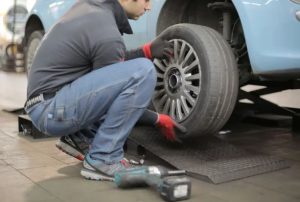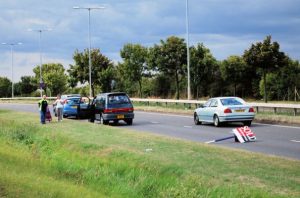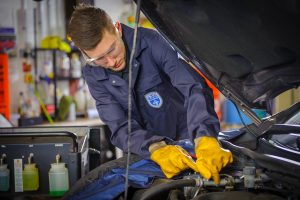Published on: 04/09/2020
Rising road traffic volumes across the UK has the potential to lead to increased chances of an accident – but how can you keep yourself and your passengers safe and your vehicle roadworthy? Find out with Trust My Garage!
According to Department for Transport (DfT) statistics, in 2019 car traffic hit the highest-ever figure of vehicle miles driven – 278.2 billion miles! Add into this recent updates on how people use public transport due to the impact of coronavirus, and it’s easy to see why mileage is at an all-time high.
With an increased number of vehicles covering more miles than ever, looking after your motor is extra important to stay safe on the UK’s road network – but how do you go about it?

Vehicle Occupant Safety
A key factor in vehicle safety is ensuring the drivers and any passengers are safe while inside the cabin. To maintain a safe and roadworthy vehicle you need to:
- Set your driving position – Drivers should have their seat pulled far enough forward so that they can fully extend the clutch pedal while maintaining a slight bend in the knee. The backrest of the seat should be tilted back ever so slightly, and when turning the steering wheel your shoulders should remain in contact with the seat – not hunched forward. The headrest should also sit higher than the driver’s ears to keep the head secure in the case of an accident.
- Check all seatbelts – look for any signs of damage, and fasten the seat belt and pull to check it’s secure with no looseness. Retraction should be smooth, as any noticeable slowness, hesitation or delay to the retraction rate or jerking movements could indicate an issue.
- Check your rear-view mirror – Sit in your normal driving position and using your left hand, grip the plastic surrounds of the mirror and move it so that you can see the entire rear window and as little of the interior as possible; essentially ‘framing’ the rear window in the mirror.
- Check your wing mirror position – Sitting in your normal driving position, adjust the right-side wing mirror so that the horizon (the point at which the road disappears into the distance) is in the centre of the mirror. Ensure there is only a very small portion of the side of your car in the left side of the mirror. Repeat with the left-side wing mirror.
- Check any child seats – The current law states that all children travelling in a car must use the correct car seat appropriate to their weight or height, until they are either 135cm in height or 12 years in age, whichever they reach first. If a seat is required, check the vehicle seat belt is running through the correct path in the child seat and that it is not twisted; it should hold the seat securely in place and resist you pushing on the seat. If you push against the seat and it moves, reassess why the seat is not locking in securely. If you are caught with an ‘unsuitable’ or wrongly fitted car seat, you could be fined £500.
- Restrain your pets – Rule 57 of the Highway Code states: “When in a vehicle make sure dogs or other animals are suitably restrained so they cannot distract you while you are driving or injure you, or themselves if you stop quickly. A seat belt harness, pet carrier, dog cage or dog guard are ways of restraining animals in cars.” There is no direct law that will penalise motorists for not obeying the Highway Code, but drivers could be fined £1,000 for driving without proper control of their vehicle if they’re pulled over by a police officer.

Plan your route(s)
Before setting off on any journey it is worth checking the routes to your destination. Ideally, have a main route and a back-up option prepared in case of unforeseen delays like traffic or road closures. Many internet search engines offer mapping functions, providing travel times based on time of day, traffic and road incidents, so you can prepare well ahead.
By doing a little homework beforehand, you could save a lot of time and avoid frustrations – which means safer journeys!

Check your vehicle’s tax and MOT status
Before you’ve even left the house, you may need to check these three important documents are valid and have enough time left on them.
About a month before your road tax expires the DVLA will issue you with a V11 Vehicle Tax Reminder, containing the information you need to either renew your tax online, via telephone or at a Post Office branch, as well as the date your current road tax period will expire. You can also check the status of your road tax or renew it online via the Gov.uk website.
If you are unsure of your vehicle’s MOT status you can use the Gov.uk MOT history checker to see when your vehicle last had an MOT, and the previous detailed information about that MOT. It’s worth ensuring that any advisory items noted at the last MOT are repaired, as these items may have deteriorated since the last MOT was carried out. As part of this service, you can also check if there are any outstanding recalls for your vehicle – where the manufacturer needs to investigate and potentially repair a problem with a certain batch of vehicles – and how to proceed if there is a recall problem. Find out more on the Gov.uk website.
Check your lights and levels
Before setting off on any journey, check your lights and levels! You can either checking them yourself or asking a friend or family member to walk around the vehicle. Make sure you check all lights – including brake lights and number plate lights – to ensure they are clear and functioning correctly.
You should also check your oil, screen wash and engine coolant levels at regular intervals – at least once a month depending on the age of your vehicle. If you aren’t sure of how to inspect your vehicle properly, you can always ask a local, trusted garage to see if or what levels and lights need topping up or replacing.

Brakes
Brakes are an essential part of any car and therefore should be regularly checked and well maintained. So, how can you tell your brakes are in tip top condition?
It’s a case of making sure you have them checked regularly. An easy way to test your brakes is by driving at a slow speed in an area or road with no traffic, and gently applying pressure.
Listen out for warning signs, as brakes will let you know when there is a problem – whether this is through grinding or squeaking. Sometimes your car will act like it has a mind of its own and pull you to one side when applying the brakes, which could indicate a fault or imbalance with the braking system. Vibrations and temperamental pedal feel are also a sign you need to give your car some attention – so look out for the signs and don’t ignore them.
Tyres
Checking your vehicle’s tyre pressure is easier than you might think! You can check and correct your tyre pressure at most UK petrol stations using a pay-per-use air and water station, or you can purchase your own tyre pressure gauge – the choice is yours.
If you aren’t sure what pressure is correct for your vehicle’s tyres you can refer to your Owner’s Manual. Details should be provided in either/both BAR and PSI, and you can adjust your pressures to the recommended figure. Often a vehicle’s tyre pressure information is also provided on the interior frame of the front passenger or driver’s door, or sometimes inside the fuel filler flap, so be sure to check there if you need a quick reference point as well.
Don’t forget to check all your tyres’ tread depths too. The legal minimum tread depth in the UK is 1.6mm across the central three-quarters, however it is recommended to keep your tyres at 3mm or above for optimum grip. Drivers who fail to comply with the regulations face a fine of up to £2,500 and three penalty points for each illegal tyre.

As well as this, don’t disregard any warning lights that may appear on your dashboard! If you are unsure of their meaning either consult your vehicle’s Owner’s Manual or visit your local Trust My Garage member, who will be able to advise of any issues with your car.
Breakdown Essentials
If you do suffer the unfortunate experience of a breakdown it’s important to keep some essentials in the car – reflective or bright clothing so you and your passengers are visible to other traffic, a fully charged mobile phone, a torch, warm clothes, comfortable and waterproof shoes, hot drinks and snacks (Telegraph). That way, when you’re waiting for some roadside assistance or a recovery vehicle you can stay warm, full and safe while trying to stave off the boredom.

More about Trust My Garage
If you take your vehicle for an MOT, service or repair at your local garage, how can you be sure of the quality of its work? At Trust My Garage, we believe that our members are the best independent garages in the UK, each one unique, but all skilled professionals who are dedicated to providing top quality work.
By using a TMG-approved member, you’re visiting a garage that adheres to a CTSI (Chartered Trading Standards Institute) approved Code of Conduct. Our code means that you and your vehicle get the best service possible, no matter which TMG member you visit – so excellent service is on your doorstep!

With over 3,000 members across the UK, you’re never far away from a TMG member. We’ve even created a handy search function so you can locate your nearest TMG-approved garage with ease.
Simply pop in your postcode and our ‘Find a Garage’ map will show you all the TMG members in your area – and you can even read reviews from other customers if you’re unsure which garage is right for your needs.
If you’re looking for more information about Trust My Garage, you can head over to our website, TrustMyGarage.co.uk. We’re also on social media, so check out our Facebook and Twitter profiles to get the latest motoring news and updates straight into your social feeds!

Leave a Reply